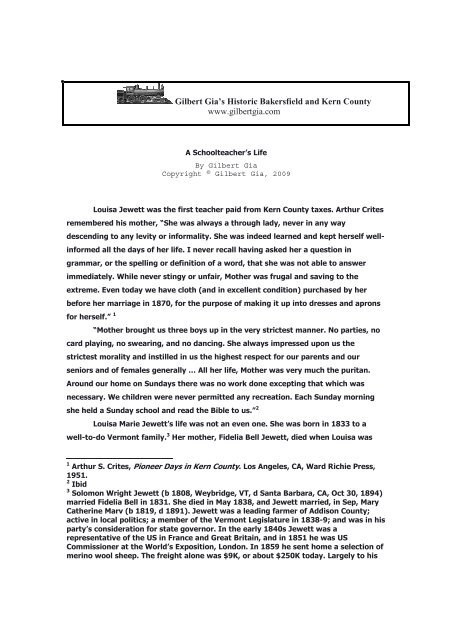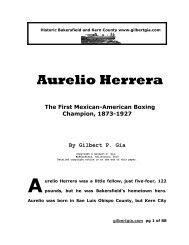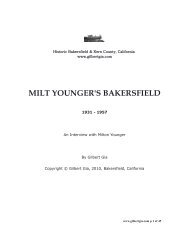A Teacher's Life, Louisa Jewett Crites, 1833-1932 - Gilbertgia.com
A Teacher's Life, Louisa Jewett Crites, 1833-1932 - Gilbertgia.com
A Teacher's Life, Louisa Jewett Crites, 1833-1932 - Gilbertgia.com
- No tags were found...
You also want an ePaper? Increase the reach of your titles
YUMPU automatically turns print PDFs into web optimized ePapers that Google loves.
Gilbert Gia’s Historic Bakersfield and Kern Countywww.gilbertgia.<strong>com</strong>A Schoolteacher’s <strong>Life</strong>By Gilbert GiaCopyright © Gilbert Gia, 2009<strong>Louisa</strong> <strong>Jewett</strong> was the first teacher paid from Kern County taxes. Arthur <strong>Crites</strong>remembered his mother, “She was always a through lady, never in any waydescending to any levity or informality. She was indeed learned and kept herself wellinformedall the days of her life. I never recall having asked her a question ingrammar, or the spelling or definition of a word, that she was not able to answerimmediately. While never stingy or unfair, Mother was frugal and saving to theextreme. Even today we have cloth (and in excellent condition) purchased by herbefore her marriage in 1870, for the purpose of making it up into dresses and apronsfor herself.” 1“Mother brought us three boys up in the very strictest manner. No parties, nocard playing, no swearing, and no dancing. She always impressed upon us thestrictest morality and instilled in us the highest respect for our parents and ourseniors and of females generally … All her life, Mother was very much the puritan.Around our home on Sundays there was no work done excepting that which wasnecessary. We children were never permitted any recreation. Each Sunday morningshe held a Sunday school and read the Bible to us.” 2<strong>Louisa</strong> Marie <strong>Jewett</strong>’s life was not an even one. She was born in <strong>1833</strong> to awell-to-do Vermont family. 3 Her mother, Fidelia Bell <strong>Jewett</strong>, died when <strong>Louisa</strong> was1 Arthur S. <strong>Crites</strong>, Pioneer Days in Kern County. Los Angeles, CA, Ward Richie Press,1951.2 Ibid3 Solomon Wright <strong>Jewett</strong> (b 1808, Weybridge, VT, d Santa Barbara, CA, Oct 30, 1894)married Fidelia Bell in 1831. She died in May 1838, and <strong>Jewett</strong> married, in Sep, MaryCatherine Marv (b 1819, d 1891). <strong>Jewett</strong> was a leading farmer of Addison County;active in local politics; a member of the Vermont Legislature in 1838-9; and was in hisparty’s consideration for state governor. In the early 1840s <strong>Jewett</strong> was arepresentative of the US in France and Great Britain, and in 1851 he was USCommissioner at the World’s Exposition, London. In 1859 he sent home a selection ofmerino wool sheep. The freight alone was $9K, or about $250K today. Largely to his
five, and her father remarried four months later. <strong>Louisa</strong> showed an early interest inbooks, and she was sent to the best Vermont schools then available for girls. 4credit the wool industry in New England became the US standard. In 1860 <strong>Jewett</strong>visited California and brought Merino sheep to Rio Bravo ranch. (History andGenealogy of the <strong>Jewett</strong>s in America… vol 2. Frederic Clarke <strong>Jewett</strong>. Grafton press,NY, 1908); http://www.archive.org/details/historygenealogy01jewe; Kern CountyGreat Register of Voters, 1866-1877 shows Solomon Wright <strong>Jewett</strong>, 58, fromVermont, farmer on Greenhorn Mt, reg Sep 24, 1866, “cancelled, left county”;Solomon <strong>Jewett</strong>, 31, from Vermont, stock raiser, Bakersfield; Philo Dennis <strong>Jewett</strong>, 29,from Vermont, stock raiser, Rio Bravo.4 <strong>Crites</strong>, op cit
<strong>Louisa</strong> <strong>Jewett</strong> graduated (about 1850) from the female seminary atMiddlebury, Addison County, Vermont. Her teacher there was Emma Hart Willard(1787-1870) who’d <strong>com</strong>e to Middlebury in 1807 to direct a girls’ school. In 1809 shemarried Rev. John Willard, and in 1814 they opened, in their home, the MiddleburyFemale Seminary. Its purpose was to prepare women for careers in teaching, and herpupils’ achievement proved that women could master classical and scientificsubjects. Willard’s Female Seminary at Middlebury became a model for teachertrainingschools in the United States. 5After graduation Miss <strong>Jewett</strong> moved to Virginia and taught at the FemaleAcademy at Clarksville. 6 By 1855 she was at Gonzales County, Texas, where she wasgoverness and tutor for a wealthy, planter family. The Census of 1860 shows 27 yearold<strong>Louisa</strong> <strong>Jewett</strong> as a public school teacher at Racine County, Wisconsin. 7 In 1866Miss <strong>Jewett</strong> , by then 33, made a trip to California. In autumn 1866 she was aboard asteamer for the Isthmus, in late December she was at San Francisco, and soon afterthat she was on a southbound stagecoach in the San Joaquin Valley. Miss <strong>Jewett</strong>’sdestination was Bakersfield and the Rio Bravo Ranch of her father and herstepbrothers at the mouth of Kern Canyon. She arrived January 17, 1867. 85 Alfred James Morrison, The Beginnings of Public Education in Virginia, 1776-1860 ,Richmond, D. Bottom, Superintendent of Public Printing, 1917; Martin’s Gazetteer ofVirginia, 1834, (Google Books online);http://ocp.hul.harvard.edu/ww/people_willard_emma.html6 Established in 1836 in Mecklenburg County. (Alfred James Morrison, The Beginningsof Public Education in Virginia, 1776-1860, 1917); Martin’s Gazetteer of Virginia,1834 (http://books.google.<strong>com</strong>)7 US Census 1860. The <strong>Jewett</strong> family removed from Vermont to Wisconsin yearsearlier. In 1850 Philo D. <strong>Jewett</strong> graduated from Racine College. History of Racine andKenosha County. Chicago, 1879, p 415, (Google Books online)8 The <strong>Jewett</strong>s established the Rio Bravo ranch in 1860. <strong>Louisa</strong>’s father visited theranch in May 1861, and he returned several times. (Louis J. Rasmussen, SanFrancisco Ship Passenger Lists, V.2 San Francisco Historic Record and GenealogyBulletin. Colma, CA.), (<strong>Jewett</strong> Diary, Jan 27, 1862. Kern County Library, microfilm);<strong>Louisa</strong>’s father said he was at Kern Island in 1862, (Kern County Californian, Dec 18,1880).
The US Census taken in Bakersfield in August 1870 showed <strong>Louisa</strong> <strong>Jewett</strong>, 37,boarding at the home of he brother Solomon <strong>Jewett</strong> and his wife and child. 11 Butwithin few months <strong>Louisa</strong> was married and living a pioneer life. 12 In the inscrutableways of the world, <strong>Louisa</strong> <strong>Jewett</strong>’s life had intersected that of a carpenter andmillwright named Angus M. <strong>Crites</strong>. 13 After the massive Kern River flood of January 1,1868 had washed away the buildings at the Rio Bravo ranch and rearranged thelandscape below Kern Canyon, the <strong>Jewett</strong>s hired a carpenter named Angus <strong>Crites</strong> toerect new ranch buildings. During that time he met <strong>Louisa</strong> <strong>Jewett</strong>. 14 In August 1870,they drove a two-horse, spring wagon to Visalia, they were married, 15 and theeastern-educated Miss <strong>Jewett</strong> with nearly 15 years of classroom experience suddenlywas a frontier wife. Between 1872 and 1881 she had four children.11 Her step-brother Philo was also living there (1870 Census); Solomon <strong>Jewett</strong> (nmn)was an early founder and builder of Bakersfield. He purchased land from the ThomasA. Baker probate. Shortly before 1870 the <strong>Jewett</strong>s bought about 2,000 acres ofchoice land near today’s Kern County Museum, (Kern County Tax Book, Jan 1, 1870,Genealogy Room, Beale Memorial Library, Bakersfield, CA); In 1872 Solomon <strong>Jewett</strong>was Kern County Supervisor, District 2. In 1874 he helped incorporate the Kern ValleyBank. The <strong>Jewett</strong>s sold the Rio Bravo Ranch in 1874 (Kern County Weekly Courier,Sep 19, 1874) and took some of their blooded sheep to their Bakersfield farm.Solomon <strong>Jewett</strong> died in 1902 in San Francisco. When the three <strong>Crites</strong> sons weregrown, all profited from their family’s relationship with the <strong>Jewett</strong>s.12 In the 1870 Census (Bakersfield Post Office Township 5), Angus M. <strong>Crites</strong> waslisted as a carpenter.13 Angus McLeod <strong>Crites</strong> (b Massena Springs, St Lawrence County, NY, 1838, d KernCounty, Sep 28, 1904). In 1853, 15 year-old <strong>Crites</strong> built a tool chest and left NewYork for the Isthmus of Darien in Columbia. He walked sixty miles across the Isthmusand took passage to San Francisco. He joined the gold rush to British Columbia.Unsuccessful, <strong>Crites</strong> returned a year later and worked in San Francisco as a carpenter.During the Civil War he built barracks at Fort Point on Alcatraz Island. A goldexcitement drew <strong>Crites</strong> to Havilah in 1864. He mined some, but his in<strong>com</strong>e derivedfrom construction of ore-crushers. <strong>Crites</strong> was never successful at mining, (PioneerDays in Kern County, op cit)14 <strong>Crites</strong>15 Ibid
Their first child was Fidelia Bell, born in 1872 in Los Angeles. 16 But <strong>Louisa</strong>’snext three children were born at home, and she delivered at least one of themwithout a doctor or midwife. 17 Angus was born in 1874, 18 Arthur 19 in 1879, andGeorge in 1881. 20 Before 1880, <strong>Crites</strong> had raised stock near Caliente, 21 but about thistime he built a family home on his quarter-section homestead by Clear Creek on theside of Bear Mountain. 22 Arthur recalled, “The house was a three-room, up-and-downboard-and-battened with a shake roof, Dad having made the shakes himself. Therewas no running water, no sink, no inside toilet or bathtub, no screens to keep thefiles out, no carpets and no linoleum. It did have a cook stove, although that wassomewhat of a luxury…” 23 Their nearest neighbor was 17 miles above at Tehachapi,and the nearest store and doctor was 30 miles below at Bakersfield.On December 24, 1883, 11 year-old Fidelia <strong>Crites</strong>, then called Della, hadridden her horse to Caliente to get the Christmas packages her father had sent fromBakersfield. 24 Arthur wrote, “Some neighboring boys played a prank and scared herhorse. She was thrown over backward, and her back, hip, and leg were broken. Shelay in the road for hours before she was picked up by an ore-wagon worker whohappened by and took her to Caliente. After many more hours she was taken toBakersfield by train and given the care of a doctor, but she died three days later.Mother never got over the shock of the death of her only daughter. I was not five atthe time, and yet I well recall how grief-stricken Mother was and how she read herBible and prayed day after day.” 2516 Ibid17 <strong>Crites</strong>, pp 37-4218 Angus Dennis <strong>Crites</strong> mined with his father around Caliente Valley, Red Rock, andSageland. When AD <strong>Crites</strong> was 23, he was hired by the <strong>Jewett</strong> and Blodget OilCompany. <strong>Crites</strong> became superintendent of the Peerless Oil Co.19 Arthur Saxe <strong>Crites</strong> was cashier of the First Bank of Kern.20 US Census 1870 (Bakersfield Post Office Township 5); Frederic Clarke <strong>Jewett</strong>, opcit; George Solomon was a supervising engineer at Tucson, AZ. Until the 1880s AngusM. <strong>Crites</strong> was in the sheep business and ranged his bands on the plans and aroundthe hills east of Bakersfield. <strong>Crites</strong> served as a Kern County Deputy Assessor, and in1876, when the railroad ended at Caliente, he was justice of the peace, (Morgan, opcit ). Like many other early sheep men, <strong>Crites</strong> was forced out of the wool business by<strong>com</strong>petition from Australian imports. He switched to the cattle business and built alarge herd.21 US Census 1870, Bakersfield Post Office Township 522 The Clear Creek home was four miles from Keene and 14 miles west of Tehachapion the old Bakersfield-Tehachapi trail23 <strong>Crites</strong>24 In the 1880 US Census, Della was shown as “Tidelia”.25 <strong>Crites</strong>
home. 30 <strong>Louisa</strong> <strong>Jewett</strong> <strong>Crites</strong> was just two months shy of her one-hundredthbirthday.30 Bakersfield Californian, Nov 7, <strong>1932</strong>; US Censuses 1910, 1920, 1930
** ** ** ** **












